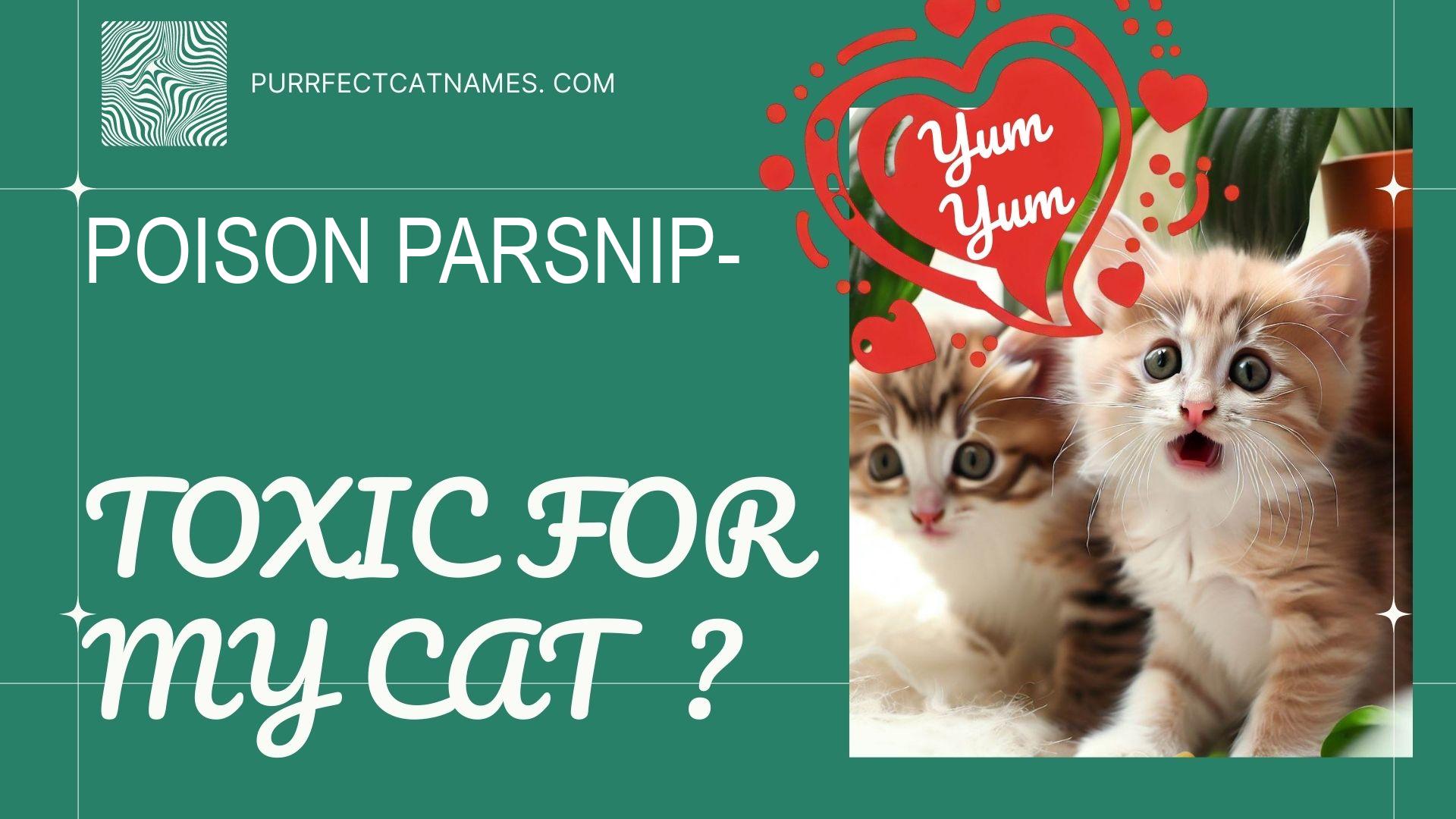
You love your Poison Parsnip plant, but did you know it could kill your cat? 😱
Cats are curious creatures, and they often nibble on plants to explore their environment. But some plants are deadly for them, and Poison Parsnip is one of them. 😵
In this article, you will discover the hidden danger of Poison Parsnip for cats, and how to protect your furry friend from it. You will learn:
- What makes Poison Parsnip toxic to cats, and how it affects their body
- The signs and symptoms of Poison Parsnip poisoning in cats, and when to seek veterinary help
- The best way to treat Poison Parsnip poisoning in cats, and how to prevent it from happening again
- How to find safe and cat-friendly plants for your home, and avoid the ones that could harm your kitty
Don’t risk your cat’s life by keeping Poison Parsnip in your home. Read this article now and find out how to make your home a safe haven for your cat. 🐱
Quick Takeaway
- Poison Parsnip is a toxic plant for cats because it contains Psoralens toxin, which can cause vomiting, diarrhea, anemia, and other symptoms if ingested.
- The toxicity depends on how much the cat eats and how sensitive they are to it. Some cats may only have mild effects, while others may need urgent veterinary care.
- The treatment involves inducing vomiting, giving activated charcoal, and providing supportive care. The prevention involves keeping the plant out of the cat’s reach or replacing it with a cat-safe alternative.
- There are many plants that are non-toxic to cats and have similar benefits as Poison Parsnip, such as spider plant, catnip, cat grass, and chamomile.
- Check the list of toxic plants for cats here: All toxic plants for cat
More About Poison Parsnip
🌿 Poison Parsnip, the hazardous and deceiving plant! ☠️🌿 Also known as “Heracleum mantegazzianum,” it’s a highly toxic and invasive plant. 🚫💀 Poison Parsnip has sap that can cause severe burns and blisters when exposed to the sun. ☀️🌿 This dangerous plant resembles harmless parsley but can reach towering heights. 🌂🌿 But be cautious; it can take over natural habitats, impacting native species. 🏞️🌿 If you encounter Poison Parsnip, do not touch it and report its presence to local authorities. 🚫🌿🚫
Why Is Poison Parsnip Toxic to Cats? 😿
Poison Parsnip is toxic to cats because it contains a Psoralens Toxin . These Psoralens Toxin have a bitter taste and can irritate the mouth, stomach, and intestines of animals that eat them.
This Psoralens toxin in Poison Parsnip is mainly found in All parts of the plant, which can be very toxic for your kitty. You should avoid giving All parts of Poison Parsnip to your cat.
How Toxic Is Poison Parsnip to Cats? 😬
The toxicity of Poison Parsnip to cats depends on how much they ingested the toxin and how sensitive they are to it. Some cats may only experience mild symptoms, such as drooling, vomiting, or diarrhea. Others may have more severe reactions, such as lethargy, depression, loss of appetite, tremors, or bloody urine.
How to Identify Poison Parsnip
⚠️ How to Identify Poison Parsnip ⚠️ Poison Parsnip, or Pastinaca sativa, is a toxic plant similar in appearance to edible parsnip. Here’s how to spot it: ➡️ Clusters of small, yellow flowers in umbrella-like inflorescences. ➡️ Compound, pinnate leaves with toothed leaflets. ➡️ Grows as a tall, upright plant. Poison Parsnip is a harmful plant that can cause skin irritation! 🚫🌿 They can be found in various habitats, including roadsides, fields, and disturbed areas. Avoid contact with the plant and prevent its ingestion. 🚫⚠️ Wear gloves when handling potentially toxic plants. 🧤🚫 Protect your skin from contact with the sap, which can cause phytophotodermatitis when exposed to sunlight. ☀️🌿 Be cautious and aware of Poison Parsnip to prevent accidental exposure! ⚠️🚫
What Are the Symptoms of Poison Parsnip Poisoning in Cats? 🤒
Because Poison Parsnip poisoning in cats can be deadly, you must be aware of early warning signs and symptoms. This way, you can get your cat the treatment they need as soon as possible and drastically limit the danger of it being a life-threatening scenario.
- Drooling
- Vomiting
- Diarrhea
- Loss of appetite
- Lethargy
- Depression
- Tremors
- Bloody urine
- Pale gums
- Rapid breathing
- Collapse
If you notice any of these symptoms in your cat, you should contact your veterinarian immediately.
Also check if your cat has bite marks on the plant’s leaves, to confirm Poison Parsnip poisoning. Speak with your veterinarian right away to seek advice on what to do. The sooner you seek medical attention, the less severe the symptoms of the poisoning will be.
Even if you cannot see any bite marks on the leaves, you should still contact your veterinarian. Something is obviously wrong with your cat. It’s plausible they took a small bite and you didn’t notice, or they were poisoned by something else in your house.
Poison Parsnip poisoning can be diagnosed by a physical exam, blood tests, urine tests, and sometimes x-rays or ultrasound.
Care for Poison Parsnip poisoned cat 💊
If your cat has eaten any part of the Poison Parsnip, the first thing you should do is call your veterinarian. They will likely provide your cat with the right treatment.
The treatment of Poison Parsnip poisoning in cats depends on the severity of the symptoms and the amount of plant material ingested. The main goals are to remove the toxin from the body and to support the vital functions.
The first step is to induce vomiting if your cat has eaten Poison Parsnip within the last two hours and is not showing signs of distress. This can be done by giving your cat a small amount of hydrogen peroxide (3%) by mouth or by taking them to the vet for professional help.
The next step is to give your cat activated charcoal. Activated charcoal is a black powder that binds to toxins in the stomach and intestines and prevents them from being absorbed into the bloodstream. It can be given by mouth or by tube feeding.
The final step is to provide supportive care. This may include fluids, electrolytes, anti-nausea medications, painkillers, antibiotics, and blood transfusions. Your cat may need to stay in the hospital for observation and monitoring until they recover.
How to Prevent Poison Parsnip Poisoning in Cats? 🚫
If you want to keep Poison Parsnip in your home, you need to take some precautions to prevent your cat from eating them. Here are some tips:
- Keep your plants in rooms that your cat cannot access. This way, you can enjoy the benefits of having plants without worrying about your cat’s safety.
- Use hanging planters to keep your plants out of reach. Hanging planters are also stylish and can add some charm to your space.
- Use cat repellent sprays to deter your cat from approaching your plants. You can buy these sprays from pet stores or make your own with vinegar, water, and essential oils.
- Use physical deterrents to make it uncomfortable for your cat to get near your plants. You can use double-sided sticky tape or spike mats to create a barrier around your plants.
- Provide lots of cat toys to keep your cat entertained and distracted from your plants. Cats are curious and playful, so they need something more fun and interesting than your plants.
By following these tips, you can keep both your cat and your plants happy and healthy. 😊
Another option is to replace your Poison Parsnip plant with a cat-safe alternative. There are many plants that are non-toxic to cats and have similar benefits as Poison Parsnip. Some examples are:
- Spider plant: This plant has long, thin leaves that are easy to grow and care for. It can help purify the air and reduce stress in cats.
- Catnip: This plant has a strong aroma that attracts cats and makes them happy and playful. It can also help with digestion and anxiety in cats.
- Cat grass: This plant has short, green blades that are rich in fiber and vitamins. It can help with hairballs and dental health in cats.
- Chamomile: This plant has small, white flowers that have a soothing effect on cats. It can help with skin irritation, inflammation, and insomnia in cats.
Here is a list of all Safe Plants for your cat: Safe Plants for Cat
What additional plants are harmful to cats?
There are other potentially lethal houseplants in our homes besides Poison Parsnip. Several of the most popular houseplants can be hazardous to cats! Before long, you start to worry about the safety of every plant in your house. We have built an Infographic of all plants toxic for a cat. Names are arranged in alphabetical order to help you find your plant.
If you want more information, check out: Plants Toxic for Your Kitty.
Conclusion 🙌
Poison Parsnip is a toxic plant for cats that can cause vomiting, diarrhea, anemia, and other serious symptoms if ingested. If your cat eats any part of Poison Parsnip plant, you should contact your veterinarian right away and follow their instructions.
To prevent Poison Parsnip poisoning in cats, you should keep the plant away from your cat or replace it with a cat-safe alternative. There are many plants that are non-toxic to cats and have similar benefits as Poison Parsnip.
Remember, your cat’s health and happiness depend on you. So be careful what you bring into your home and always check the toxicity of any new plants before introducing them to your cat.
We hope this article has helped you understand the dangers of Poison Parsnip for cats and how to avoid them. If you have any questions or comments, please let us know below. We would love to hear from you! 😊
References
PetMD – Cat Care:
Website: https://www.petmd.com/cat/care
Description: PetMD is a comprehensive resource for cat care, providing expert advice on various aspects of feline health, behavior, nutrition, and general well-being. Whether you’re a new cat owner or a seasoned feline enthusiast, PetMD offers valuable information to help you take the best care of your furry friend.
ASPCA – at-Safe Plant List:
Website: https://www.aspca.org/pet-care/animal-poison-control/cats-plant-list
Description: The ASPCA (American Society for the Prevention of Cruelty to Animals) offers a valuable resource for pet owners concerned about toxic plants that could potentially harm their feline companions. The Cat-Safe Plant List provides an extensive guide to various plants that are safe for cats, helping you create a pet-friendly environment for your beloved kitty.









